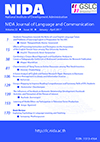Combining a Corpus-Based Approach and Qualitative Analysis to Create a Pedagogically Useful List of Multiword Combinations for Research Publication
Keywords:
Academic word list, TCI database, English for Academic Purposes, Writing for publicationAbstract
University lecturers and graduate students have been under increasing pressure to publish their research work in prestigious journals. Among other things, multiword sequences seem to be challenging for novice writers and graduate students struggling to make their manuscripts convincing and interesting for potential readers in their research communities. This study reports on the frequency and use of phraseological patterns in applied linguistics research articles. Using corpus linguistics methodology in combination with qualitative analysis, the present study identified phraseological patterns frequently co-occurring in research articles, their structural types, and pragmatic functions in contextual environments. To begin with, two, three, and fourword n-grams were extracted from a corpus of the four internal sections of 50 research articles (equating to approximately 205,187 running words) to identify the suitable ngrams to focus on. Based on their semantic and grammatical relations, three-grams appeared to be pedagogically interesting, were further explored. Five EAP instructorswere invited to select the strings identified, contributing to a pedagogically useful list of 289 multiword combinations. The results of the structural analysis indicated that the majority of writers employed amount of noun-based structures most, followed by other structures, verb-based and prepositional-based structures. Functional analysis clearly revealed that the use of certain phraseological patterns was strongly associated with the communicative functions of a given section of the texts. Pedagogically, this study sheds light on language use in this particular writing research genre and provides more evidence-based instructional practices, especially advanced language courses targeted at scholarly reading and writing.
Downloads
How to Cite
Issue
Section
License
By submitting a manuscript, the author transfers the copyright for the article to School of Language and Communication, National Institute of Development Administration (NIDA), if and when the manuscript is accepted for publication. Though the journal is an open-access, reproduction of any material published in NIDA Journal of Language and Communication for non-personal and/or commercial purpose requires a written permission from School of Language and Communication, National Institute of Development Administration (NIDA).






